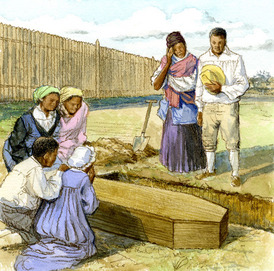African Burial Ground
The AFBG is a federally designated historic landmark and archaeological site that was used as a cemetery by free and enslaved people of African descent during the seventeenth and eighteenth centuries. It’s believed that between 10,000 and 20,000 people are buried here. The site covers approximately 7 acres and is bounded by Duane Street on the north, Chambers Street on the south, Centre and Lafayette Streets on the east, and Broadway to the west.
In 1991, archaeological fieldwork began. While excavating a site for a new building at 290 Broadway, construction workers discovered skeletal remains of early Africans. The site was designated a National Historic Landmark in 1993 because of its unprecedented potential to provide information about the lives of early Africans, including their quality of health and the region of Africa they came from. (One previously unknown fact: The mortality rate for children under 16 years old was 43% based on a sample of 301 individuals buried at the site.) The information gathered by archaeologists and historians significantly altered historical misconceptions about the life and culture of Africans. And burial practices revealed at the site reflected the cultural and religious beliefs of enslaved people that had previously been undocumented -- such as the fact that many of the people buried here had played a significant role in the building of New York City.
Mayor David Dinkins, Lt. Gov. David Patterson, Illinois Congressman Gus Savage, Dr. Michael Blakey, and a Howard University team of researchers deserve recognition for the key role that they played in preserving this crucial part of African American history.
This entry contributed by
Curriculum Concepts International
Related Media
Video

|
Dowoti Desir, Executive Director of The Malcolm X and Dr. Betty Shabazz Memorial and Educational Center, describes first learning about the African Burial Ground.
|

|
Dowoti Desir, Executive Director of The Malcolm X and Dr. Betty Shabazz Memorial and Educational Center, describes what the discovery of the African Burial Ground has revealed about the lives of Africans in colonial New York City.
|

|
Columbia University Professor of History Kenneth Jackson discusses the African Burial Ground.
|

|
Kellie Jones, Columbia University Professor of Art History and Archeology, discusses the African Burial Ground.
|

|
Architect Rodney Leon, who designed the memorial marking New York City's African Burial Ground, describes choosing the materials for this historic landmark.
|

|
Architect Rodney Leon, who designed the memorial marking New York City's African Burial Ground, discusses the feelings he hoped to invoke in those visiting the site.
|

|
Architect Rodney Leon, who designed the memorial marking New York City's African Burial Ground, describes the seven elements of the site, and the unique experience of visiting the site in person.
|

|
A New York high school student reflects on his discovery of the African Burial Ground Memorial.
|
Images

|
The African Burial Ground National Monument memorial is located at Duane and Elk Streets. An exhibit at the visitor center is located at 290 Broadway on the ground floor.
|

|
For most of the 1700s, and maybe earlier, Africans and their descendents kept their own burial ground north of the city and its wall. The coffins were laid facing east.
|
